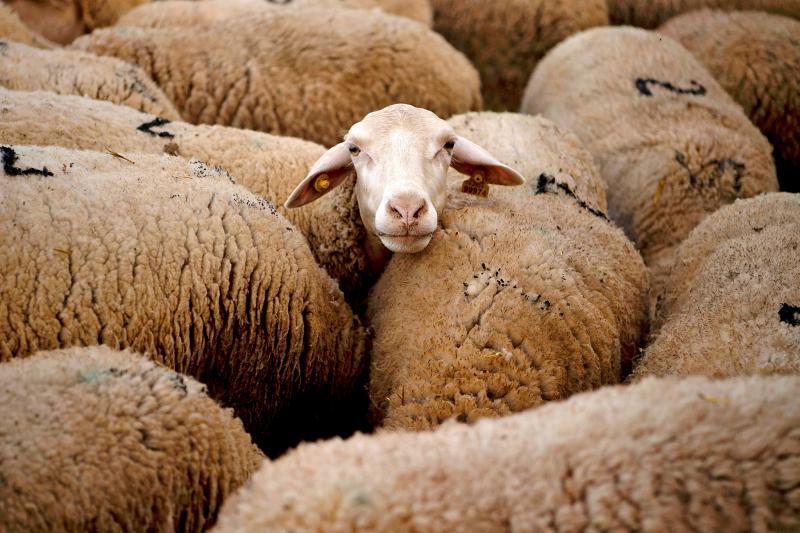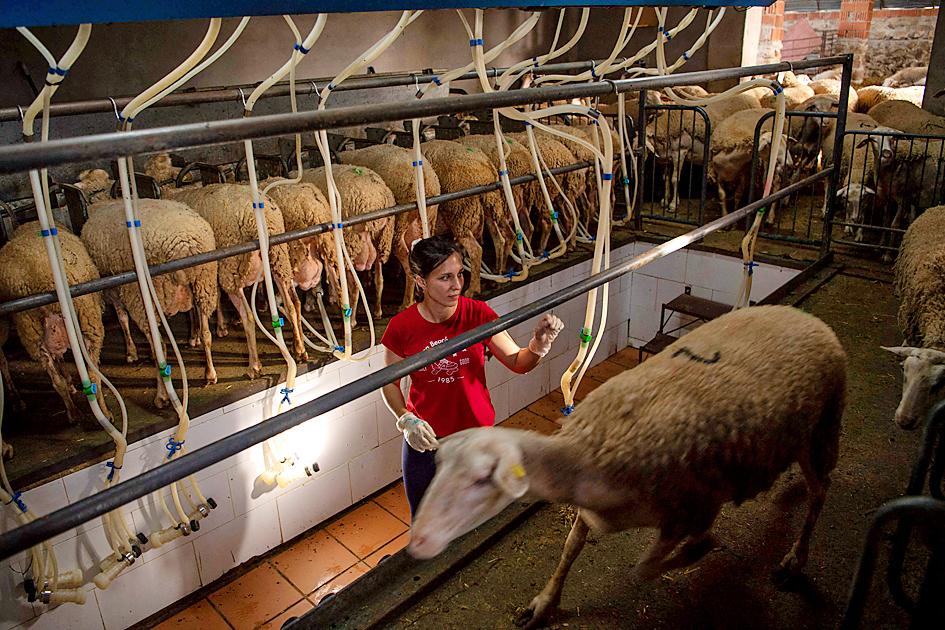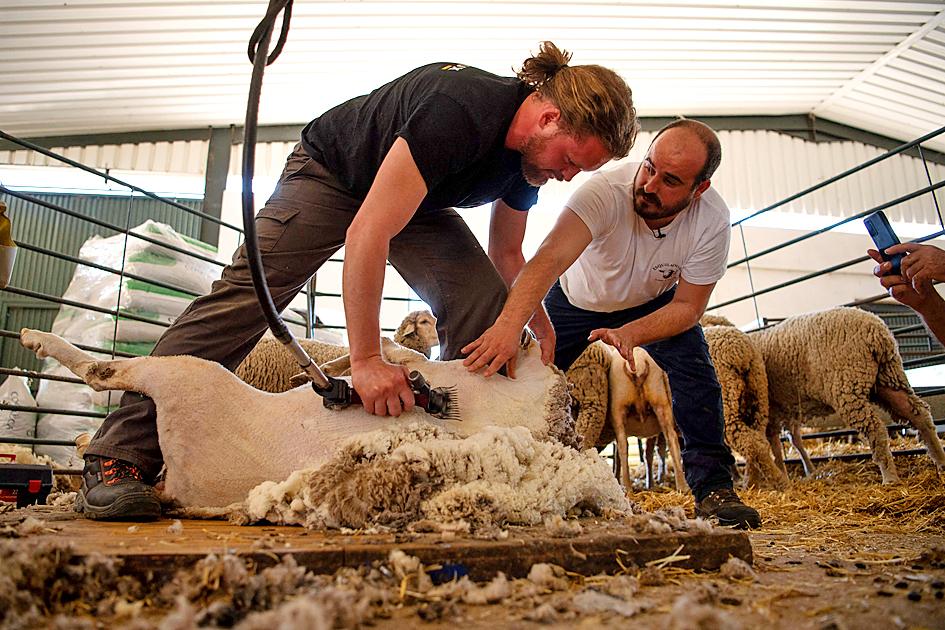Gripping a sheep firmly between her legs, Vanesa Castillo holds its head with one hand while she tries to shear off its thick fleece with electric clippers.
“It’s scary,” said Castillo, 37, slightly unnerved by her first attempt at sheep shearing at a school for shepherds in western Spain.
“You have to pull the animal’s skin taut, really slowly, so you don’t cut it,” said Jose Rivero, the professional sheep shearer giving the course.

Photo: AFP
Sheep shearing is just one of the classes offered at the school in Casar de Caceres in rural Extremadura to counter the flight from the land that has left large swathes of inland Spain thinly populated.
Set up in 2015, the idea was “to bring in people who love the countryside,” said Enrique “Quique” Izquierdo, who runs the school.
It aims to provide all the training and resources needed to create “a shepherd for the 21st century ... with the most up-to-date methods in a sector where the traditional and the cutting-edge merge.”

Photo: AFP
Much of Spain’s sheep and goat farming is concentrated in rugged Extremadura. The school at Casar de Caceres is one of several across the country, the first set up in the northern Basque Country in 1997.
“The traditional image of a shepherd wandering through the fields all day” does not exist anymore, said Jurgen Robledo, a vet who said the students are taught how to use many high-tech tools including milk control programs.
This year, 10 students are taking the five-month course, which also includes hands-on experience working with animals.

Photo: AFP
Thibault Gohier, 26, is learning how to milk goats and to identify whether any of them are sick, which could affect the quality of their milk.
“You need to use your fingertips as if they were your eyes,” said Felipe Escobero, who heads the farm where the school is based, as they feel a black goat’s mammary lymph nodes at the top of the udder.
When they are healthy, “they should feel like an almond,” Escobero added.
The course also covers financial matters and how to fill out certificates attesting to animal welfare or pesticide use.
Completely free, it is funded by the Cooprado livestock farmers’ cooperative.
Robledo said modern high-tech tools mean shepherds can now “measure the individual [milk] production of each animal.”
“Such data can let a farmer see if production has dropped due to a subclinical mastitis infection by detecting a drop in production in a certain number of animals,” Robledo said.
Unlike normal mastitis, such infections do not cause any visible changes to the milk or udder appearance, making them difficult to detect, although they do affect the farmer’s bottom line by reducing milk production and quality.
Some students already work in farming and want to specialize, while others are completely new to the field, such as Castillo, who is taking the course with her 17-year-old daughter Arancha Morales.
Originally employed at an old people’s home until it shut down two years ago, leaving her scrambling for work, her dream now is to have a sheep farm.
“We’re looking for a way to bring home some money,” said her daughter, whose father cannot work after having an accident.
Both women know they face an uphill battle, above all to find an affordable piece of land for their flock, a common problem across Extremadura.
Thibault Gohier comes from a very different background.
A young Frenchman who loves animals and the countryside, his dream is to have “a bed and breakfast with a small farm attached with about 30 animals” in a mountainous area of France.
As the other students are learning to shear, El Ouardani El Boutaybi is feeding dozens of restless goats who are scampering around a pen.
“I did the shepherds’ school and all the practical courses in June 2020 ... and then they took me on to work with them,” said the 20-year-old, who comes from the coastal town of Nador in northeastern Morocco.
He got to Spain in 2017 after crossing the fence into the Spanish enclave of Melilla in North Africa, where he spent time in a center for unaccompanied minors before being transferred to the peninsula.
“I’ve got a future working in the countryside,” he said proudly.

Quanta Computer Inc (廣達) chairman Barry Lam (林百里) is expected to share his views about the artificial intelligence (AI) industry’s prospects during his speech at the company’s 37th anniversary ceremony, as AI servers have become a new growth engine for the equipment manufacturing service provider. Lam’s speech is much anticipated, as Quanta has risen as one of the world’s major AI server suppliers. The company reported a 30 percent year-on-year growth in consolidated revenue to NT$1.41 trillion (US$43.35 billion) last year, thanks to fast-growing demand for servers, especially those with AI capabilities. The company told investors in November last year that

United Microelectronics Corp (UMC, 聯電) forecast that its wafer shipments this quarter would grow up to 7 percent sequentially and the factory utilization rate would rise to 75 percent, indicating that customers did not alter their ordering behavior due to the US President Donald Trump’s capricious US tariff policies. However, the uncertainty about US tariffs has weighed on the chipmaker’s business visibility for the second half of this year, UMC chief financial officer Liu Chi-tung (劉啟東) said at an online earnings conference yesterday. “Although the escalating trade tensions and global tariff policies have increased uncertainty in the semiconductor industry, we have not

Intel Corp has named Tasha Chuang (莊蓓瑜) to lead Intel Taiwan in a bid to reinforce relations between the company and its Taiwanese partners. The appointment of Chuang as general manager for Intel Taiwan takes effect on Thursday, the firm said in a statement yesterday. Chuang is to lead her team in Taiwan to pursue product development and sales growth in an effort to reinforce the company’s ties with its partners and clients, Intel said. Chuang was previously in charge of managing Intel’s ties with leading Taiwanese PC brand Asustek Computer Inc (華碩), which included helping Asustek strengthen its global businesses, the company

Power supply and electronic components maker Delta Electronics Inc (台達電) yesterday said it plans to ship its new 1 megawatt charging systems for electric trucks and buses in the first half of next year at the earliest. The new charging piles, which deliver up to 1 megawatt of charging power, are designed for heavy-duty electric vehicles, and support a maximum current of 1,500 amperes and output of 1,250 volts, Delta said in a news release. “If everything goes smoothly, we could begin shipping those new charging systems as early as in the first half of next year,” a company official said. The new